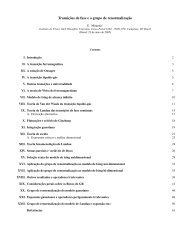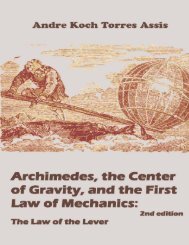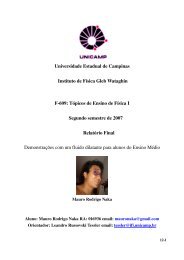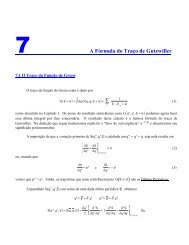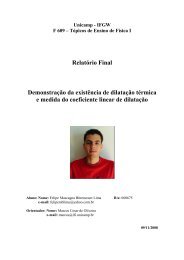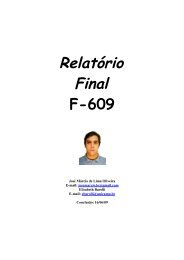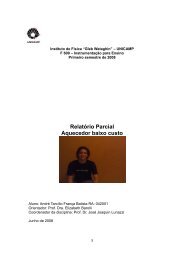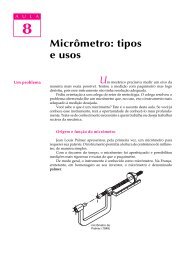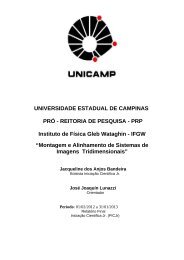The Experimental and Historical Foundations of Electricity - Unicamp
The Experimental and Historical Foundations of Electricity - Unicamp
The Experimental and Historical Foundations of Electricity - Unicamp
You also want an ePaper? Increase the reach of your titles
YUMPU automatically turns print PDFs into web optimized ePapers that Google loves.
7.10 Can Two Bodies Electrified with Charges<br />
<strong>of</strong> the Same Sign Attract One Another?<br />
Experiment 7.23<br />
WerepeatExperiment6.5(Figure6.7). Butnowthenegativestrawismoved<br />
even closer to the strip <strong>of</strong> the negatively charged electroscope. We observe that<br />
for distances smaller or equal to a certain value, <strong>of</strong> the order <strong>of</strong> 2 to 4 cm, the<br />
strip is no longer repelled by the straw, being attracted by it. <strong>The</strong> strip touches<br />
the straw <strong>and</strong> remains attached to it.<br />
Experiment 7.24<br />
We repeat Experiments 4.7 <strong>and</strong> 5.23 (Figures 4.18 <strong>and</strong> 5.27). But now<br />
the negative straw is moved even closer to the negative disk <strong>of</strong> the pendulum.<br />
We observe that the inclination <strong>of</strong> the pendulum from the vertical increases<br />
when the distance between the straw <strong>and</strong> the pendulum goes from 15 to 5 cm,<br />
approximately. This shows that the intensity <strong>of</strong> the repulsive force increases<br />
when the distance between them decreases in this range.<br />
However, for distances less than or equal to certain value, <strong>of</strong> the order <strong>of</strong> 5<br />
cm, there is no longer a repulsion between the negative straw <strong>and</strong> the negative<br />
disk. At these small distances they attract one another. <strong>The</strong> disk touches the<br />
negative straw a second time <strong>and</strong> is again repelled by it.<br />
After 2 or 3 <strong>of</strong> these contacts between the negative straw <strong>and</strong> the disk <strong>of</strong> the<br />
pendulum, the same phenomena are once more observed, but over somewhat<br />
different distances. When the disk has a greater degree <strong>of</strong> electrification, the<br />
repulsion between the disk <strong>and</strong> the negative straw can be observed at a distance<br />
larger than before, <strong>of</strong> the order <strong>of</strong> some 20 cm. <strong>The</strong> intensity <strong>of</strong> the repulsive<br />
force increases when this distance is decreased between 20 cm <strong>and</strong> a lower limit<br />
<strong>of</strong> 2 or 3 cm. When the distance between the straw <strong>and</strong> the disk has a value<br />
less than or equal to this lower limit, there is again an attraction between them,<br />
<strong>and</strong> the ACR mechanism comes into play.<br />
<strong>The</strong>se experiments can be understood on the basis <strong>of</strong> the principles discovered<br />
so far.<br />
Let us suppose that a body �, an insulator, has been charged negatively by<br />
friction. It is close to a neutral body ��, a conductor, which has no net charge.<br />
<strong>The</strong>re will be an attractive force between them. This attractive force is due to<br />
the polarization <strong>of</strong> body �� in the presence <strong>of</strong> body �, as in Figure 7.29. We<br />
represent their attractive force by �� > 0 (Figure 7.32 (a)). We now electrify<br />
body �� with a charge <strong>of</strong> the same sign as the charge <strong>of</strong> the attracting body<br />
�. This can be done, for instance, by the ACR mechanism. This will generate<br />
a new force between them. It is repulsive <strong>and</strong> it will be represented here by<br />
�� < 0. In Figure 7.32 (b) we present this new force <strong>of</strong> repulsion, disregarding<br />
the previous attractive force due to the polarization <strong>of</strong> the conductor. <strong>The</strong> new<br />
negative charge on the conductor is represented in the middle <strong>of</strong> body �� only<br />
202



